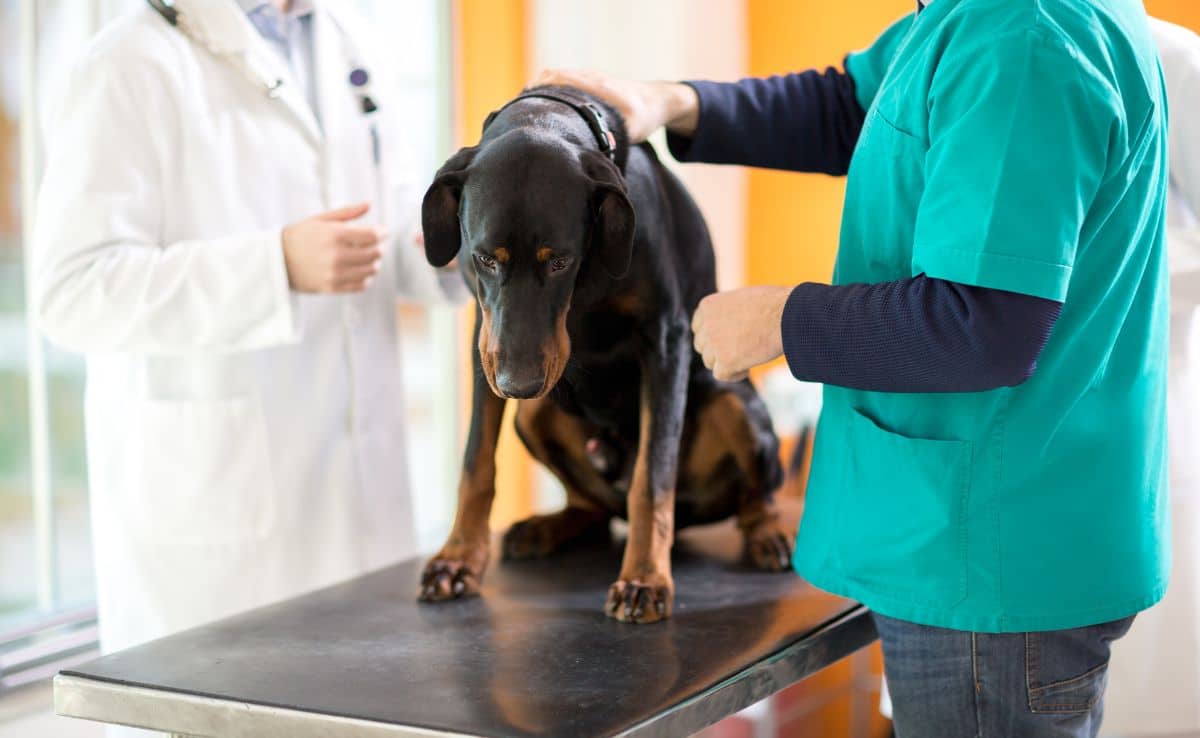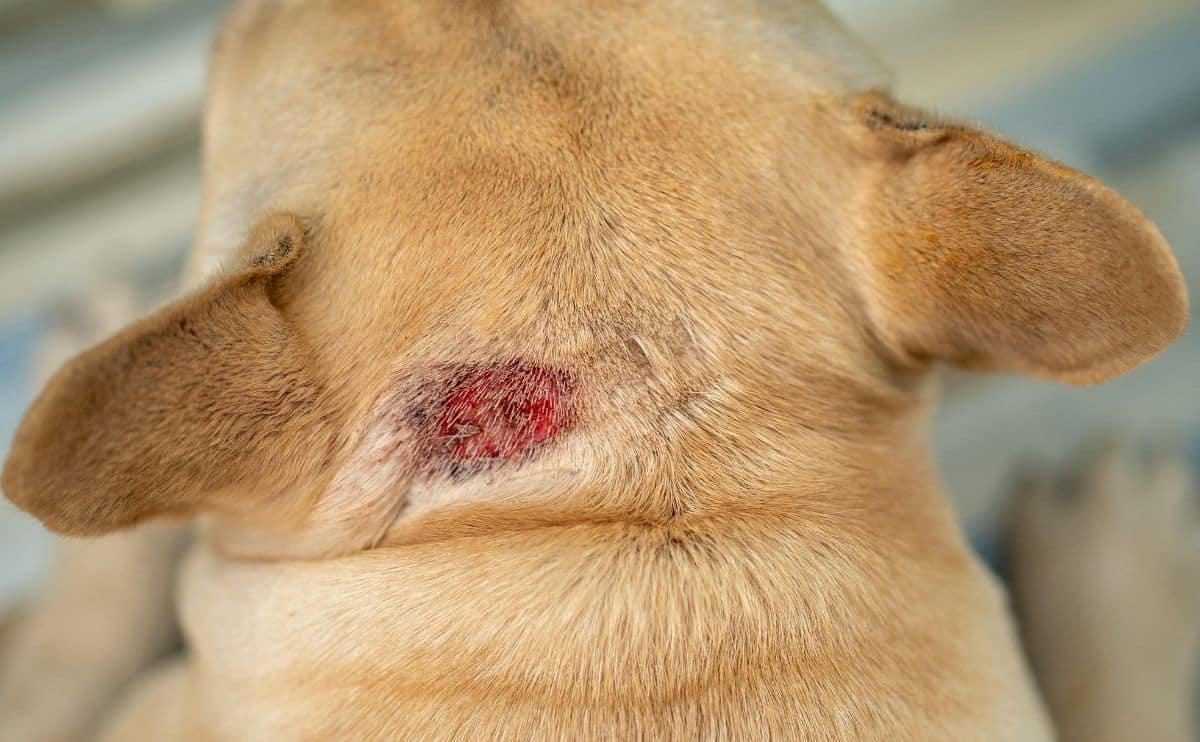Hemangiosarcoma In Dogs: Symptoms, Causes, Treatment & More
When you purchase through links on our site, we may earn a commission. Here’s how it works.

Every pet parent dreads their furry family member being diagnosed with cancer. Hemangiosarcoma is a type of blood vessel cancer in dogs that can affect the liver, spleen, skin, or internal organs and poses a serious risk to their health. Let’s find out more about this type of cancer in dogs, how it is diagnosed, treatment options, and what this diagnosis means for your dog.
Table of Contents
What Is Hemangiosarcoma In Dogs?
Hemangiosarcoma (HSA) is a highly aggressive, malignant neoplasm (cancer) of the cells that line blood vessels known as endothelial cells. Cancer develops from the rapid, uncontrolled division of these cells, forming a tumor. Cancer can be found in any organ that is rich in blood vessels, but in dogs, it is most commonly found in the spleen or liver.
Other primary locations include the right atrium, one of the top chambers of the heart, the skin (cutaneous hemangiosarcoma), and the subcutaneous tissues (the layer of fat and tissue beneath the skin). Hemangiosarcoma that affects the internal organs is also referred to as ‘visceral’ hemangiosarcoma. The disease may spread from the primary location to other areas of the body, such as the brain, heart, lungs, skeletal muscle, or kidneys.
The tumors that develop are rapidly growing and given that they develop from cells within blood vessels, they are filled with blood. Because the tumors grow rapidly, they are prone to rupturing, which can result in internal bleeding into the abdomen, chest, or pericardium (the sac that surrounds the heart). This bleeding can lead to further complications or can even be fatal for some dogs.
Hemangiosarcoma In Dogs Symptoms
The symptoms of hemangiosarcoma depend on where the tumor develops in the body. Hemangiosarcoma of the skin usually appears as a lump on the surface or beneath the skin. Visceral hemangiosarcoma may cause signs associated with blood loss, such as weakness, reduced ability to exercise, lethargy, or a reduced appetite.
Many dogs do not show symptoms of the disease until the tumor ruptures, and it causes internal bleeding. This can cause sudden onset collapse and heart arrhythmias. If this occurs, your dog may have difficulty standing, have very pale gums, the abdomen may appear distended with fluid, and they could appear very weak. If you observe weakness or collapse in your dog, seek urgent veterinary advice.
Which Dogs Get Hemangiosarcoma?
Any dog can develop this type of cancer. It is more common in dogs over the age of 8 years, and some breeds are more susceptible to the disease. Larger breed dogs such as German Shepherds, Golden Retrievers, Boxers, Pointers, and Labradors are over-represented. The cutaneous (skin) form of hemangiosarcoma can occur in dogs from 4 years of age upwards. Again, any breed of dog can be affected, but Whippets, Basset Hounds, and Dalmatians are over-represented. Sun exposure may be a risk factor for the development of cutaneous hemangiosarcoma.
Hemangiosarcoma In Dogs Skin
Two different forms of hemangiosarcoma in the dog exist:
Subcutaneous Hemangiosarcoma In Dogs
The subcutis, or subcutaneous tissue, is the layer immediately beneath the skin. Blood-filled growths can develop in this layer which can be palpated as a lump beneath the skin. The overlying skin may look completely normal. Up to two-thirds of these masses spread internally.
Cutaneous Hemangiosarcoma In Dogs
Cutaneous or dermal hemangiosarcoma typically appears as a red or black growth on the surface of the skin. These masses can become ulcerated and bleed. They can vary in size from the size of a pea to the size of a fist. Around one-third of these masses will spread to internal organs.
Hemangiosarcoma of the skin is often detected earlier in the disease process compared to visceral forms of the disease simply because the skin is visible, and masses are more easily detected. For this reason, the prognosis may be better as surgical removal is possible before the spread has occurred.
What Causes Hemangiosarcoma In Dogs?
The cause of hemangiosarcoma in dogs is unknown. The fact that certain breeds of dogs are more likely to get this type of tumor means there may be a genetic cause of the disease. Most cancers occur from a random mutation of genes as cells in the body are dividing to replace themselves, and there is no specific cause. Some external factors such as nutrition, tobacco smoke, pesticides, UV light, and pollution can increase the chance of these mutations and tumor formation.
How Is Hemangiosarcoma Diagnosed In Dogs?
Your veterinarian will need to perform a number of tests to diagnose hemangiosarcoma. Ultimately, a diagnosis can only be made by histopathology which is a laboratory test performed on a sample of the abnormal tissue (biopsy) or removal of the tumor. The appearance of skin or subcutaneous masses may lead to a vet advising a biopsy or surgical removal of the mass and laboratory testing.
Diagnosing visceral forms of hemangiosarcoma can be more challenging. Dogs with hemangiosarcoma of the heart, spleen, or liver often arrive as an emergency with severe internal bleeding. Ultrasound and x-rays of the abdomen may be used to identify a mass on one of the major abdominal organs. Surgical removal of the spleen may be needed to stop bleeding and diagnose the type of tumor involved. Different forms of masses exist on the spleen, not all of which are cancerous. Because splenic tumors often present as an emergency, decisions regarding surgery often have to be made before a clear diagnosis and prognosis can be given.
Blood tests to assess anemia following bleeding, organ function, and blood clotting are also necessary. Ultrasound scans, x-rays, and CT scans may be needed to ‘stage’ cancer and look for evidence of metastasis (spread) to other organs.
How Is Canine Hemangiosarcoma Staged?
Staging describes the extent or severity of an animal’s cancer, particularly if cancer has spread or metastasized to other organs away from the primary location. Staging gives information regarding prognosis and helps veterinary professionals plan treatment options.
Visceral hemangiosarcoma can be classified by a three-stage classification scheme:
- Stage I hemangiosarcoma: The tumor is confined to the primary organ only (e.g., the spleen)
- Stage II hemangiosarcoma: Ruptured splenic tumor with or without spread to local lymph nodes
- Stage III hemangiosarcoma: Spread to distant lymph nodes or other organs
Treatment For Hemangiosarcoma In Dogs
Surgery is the treatment of choice for hemangiosarcoma in dogs. Tumors of the skin and subcutis can be surgically removed with margins of normal skin. Treatment of splenic hemangiosarcoma involves surgery to remove the spleen, known as a splenectomy. Removing the spleen is a major operation and can be risky, with some dogs not surviving the procedure. Hemangiosarcoma that affects the heart or liver is more challenging to remove and, unfortunately, is not always possible.
Treatment of both cutaneous and visceral hemangiosarcoma in dogs is aided by the use of chemotherapy drugs in addition to surgery. Many different protocols are used depending on the stage of cancer. Your veterinarian will be able to discuss different options following surgery. Chemotherapy drugs such as doxorubicin, vincristine, or cyclophosphamide are most commonly administered. These may be administered intravenously (into the vein) or orally in tablet form.
How To Prevent Hemangiosarcoma In Dogs
Given that the exact cause of hemangiosarcoma is unknown, prevention is not possible. Ensuring your dog has well-balanced, healthy nutrition and access to regular veterinary care is all you can do to try and prevent this type of cancer.
Is Hemangiosarcoma In Dogs Painful?
In the early stages of hemangiosarcoma, the tumors do not cause pain. As the tumor starts to grow and bleed, it may be associated with pain, particularly abdominal pain in the case of visceral hemangiosarcoma. The rupture of a splenic hemangiosarcoma and internal bleeding is a very painful condition that can rapidly become life-threatening. Emergency veterinary treatment should be sought if your dog collapses or you suspect internal bleeding.
Hemangiosarcoma In Dogs Life Expectancy
Sadly, hemangiosarcoma is an aggressive form of cancer and the prognosis is poor. Skin and subcutaneous hemangiosarcoma carry a better prognosis than visceral hemangiosarcoma. Low-grade or stage I hemangiosarcoma in dogs is associated with an average survival time of 2 years. Stage II and III tumors that have invaded the muscle layer or lymph nodes have a worse prognosis if treated with surgery alone. However, chemotherapy may improve survival times.
Hemangiosarcoma of the spleen carries a poor outlook. They have often spread to other organs at the time of diagnosis, even if this metastasis cannot be detected on scans and x-rays. Surgery alone is associated with an average survival time of 3 months, with less than 10% of dogs surviving one year. If chemotherapy is used following surgery, survival may be extended up to 6-9 months. Dogs that present with internal bleeding into the abdomen, known as a hemoabdomen, have a worse prognosis than those whose tumor is detected before it ruptures.
What Are End Stages Of Hemangiosarcoma In Dogs?
Hemangiosarcoma is a rapidly progressive tumor that leads to bleeding from the mass and eventually rupture of the tumor and associated organ. This results in signs of severe internal bleeding and is a painful process. Even following surgical removal of the primary tumor spread to other organs is common. The tumor most commonly spreads to the liver and lungs, resulting in inappetence, weight loss, internal bleeding, and breathing problems.
Hemangiosarcoma is a serious diagnosis for dogs that often presents as an emergency, meaning difficult decisions such as whether to proceed with surgery need to be made often before a diagnosis is clear. Your veterinary surgeon will be able to talk you through treatment options and support you with decision-making so that you can make the best-informed decision for the health of your pet.



